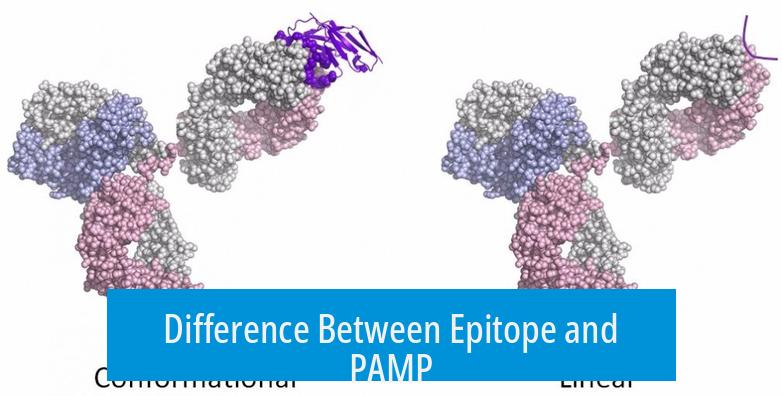Difference Between Epitope and PAMP

The key difference between epitope and PAMP lies in their roles in the immune response: a PAMP is a molecular pattern recognized by the innate immune system, while an epitope is a specific part of an antigen recognized by antibodies generated by the adaptive immune system.
Definition and Chemical Nature
- PAMP (Pathogen-Associated Molecular Pattern): These are molecular structures commonly found on pathogens. PAMPs can include various chemical types such as sugars, lipids, or proteins. They serve as a first-line recognition signal for the innate immune system.
- Epitope: An epitope is a precise region or sequence within a protein or other antigen structure. It is the part where antibodies bind. Epitopes are not necessarily limited to pathogen proteins and form the basis of adaptive immunity.
Functional Differences
PAMPs trigger innate immune responses by binding to pattern recognition receptors (PRRs) and alerting the body to common microbial signatures. Epitopes function in adaptive immunity. They are recognized by antigen-specific antibodies and T-cell receptors, enabling a targeted immune response.
Relationship Between the Two
PAMP molecules can contain epitopes since they are antigens with specific protein regions. However, not all epitopes belong to PAMPs. Many epitopes are found on non-pathogenic or self proteins, serving different immune or laboratory purposes.
Related Concepts
- DAMPs (Damage-Associated Molecular Patterns): These are host molecules released from damaged cells, functioning similarly to PAMPs in triggering immune responses but without pathogen involvement. They too have epitopes recognized by antibodies.
- Laboratory Uses: Antibodies targeting epitopes are heavily used in labs as markers for proteins, unrelated to immune defense.
Summary Table
| Aspect | PAMP | Epitope |
|---|---|---|
| Definition | Molecular patterns on pathogens recognized by innate immunity | Region of antigen that binds to an antibody |
| Chemical Nature | Sugars, lipids, proteins, etc. | Specific amino acid sequences or molecular shapes within proteins or antigens |
| Immune System Role | Activates innate immune responses | Target of adaptive immune responses (antibodies and T-cells) |
| Scope | Only non-self microbial patterns | Can be self or non-self antigens |
Key Points
- PAMPs are broad microbial markers for innate immunity and include various molecular types.
- Epitopes are specific protein regions recognized by antibodies and define adaptive immunity targets.
- Not all epitopes come from PAMPs; some are parts of self-proteins or lab markers.
- DAMPs represent another class triggering immune responses without pathogen involvement.





Leave a Comment